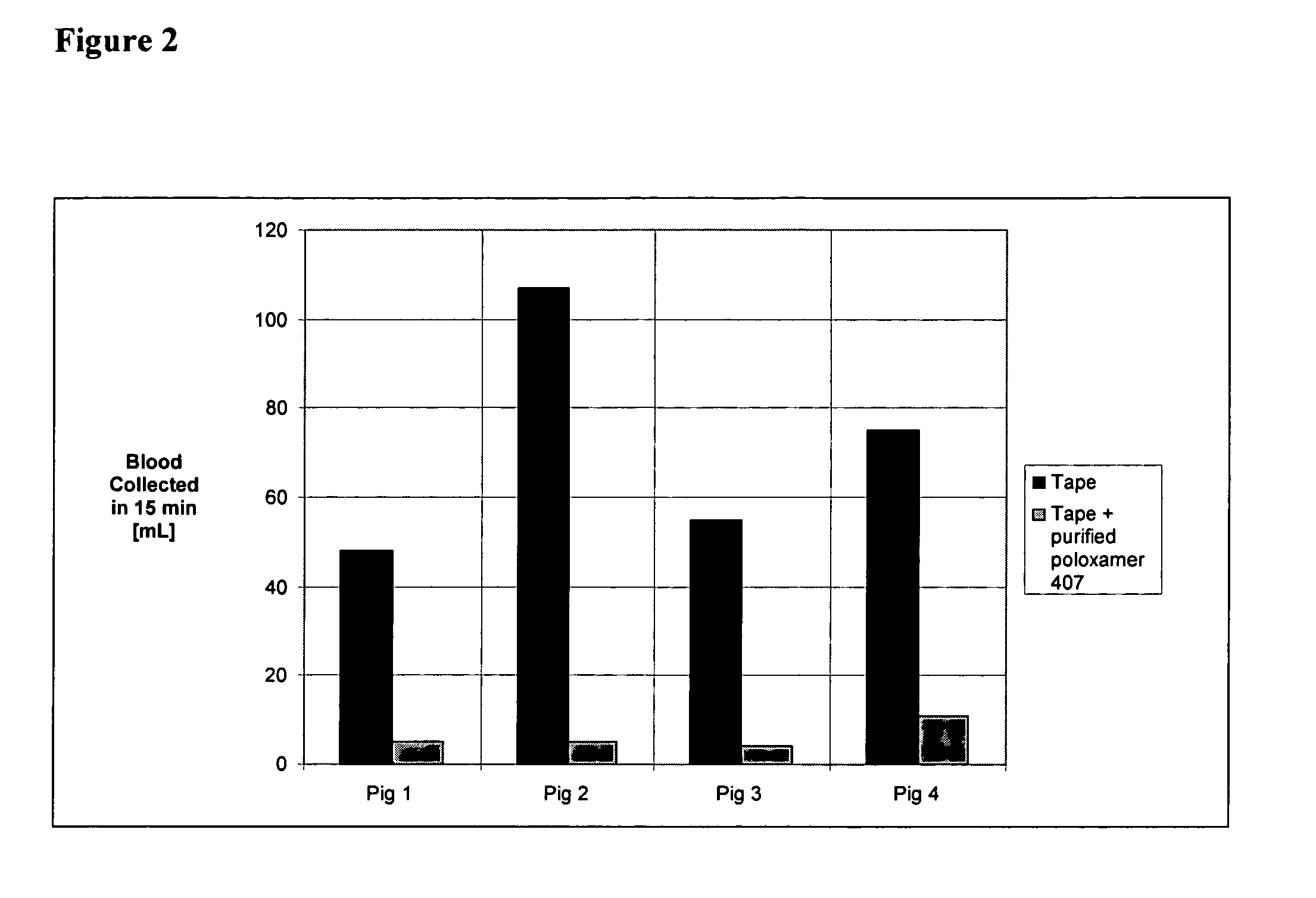Internal clamp for surgical procedures
a surgical procedure and clamping technology, applied in the field of internal clamping for surgical procedures, can solve the problems of inability to withstand calcified blood vessel plaque, thickening and narrowing of arteries, etc., and achieve the effect of reducing bleeding through the incision
- Summary
- Abstract
- Description
- Claims
- Application Information
AI Technical Summary
Benefits of technology
Problems solved by technology
Method used
Image
Examples
example 1
In-Vitro Testing and Principal of Operation
[0150]The viscosity changes were measured in a Brookfield Cone and Cup viscometer with temperature control. A graph of the viscosity changes (FIG. 1) clearly shows polymer concentrations from approximately 12.5 w % until at least 20 w % will show steep increases in solution viscosities with temperature. The onset of gelation is dependent on the temperature and higher polymer concentrations lead to earlier onsets of gelation. Furthermore, polymer concentrations below approximately 12.5 w % do not demonstrate an increase in solution viscosity with temperature and remain liquid even at body temperature.
[0151]These two findings demonstrate the potential operation principle of the purified poloxamer 407. The polymer solution is injected as a soft gel at the temperature of a typical OR (about 18° C.) into the arteriotomy and the rise in temperature leads to a stiff gel. The gel will start to dissolve in blood and when the concentration of the pol...
example 2
Injectability of Purified Poloxamer 407 Through Various Needle Gauges
[0152]A three milliliter polycarbonate syringe (Merrit Medallion) was loaded in the cold with three milliliter of 20 w % purified poloxamer 407. Various sized needles were attached via a luer lock and the injectability of the polymer solution was tested at 6° C. (liquid state) and at room temperature (23° C.; soft gel state) as shown in the table below.
[0153]
TABLE 1Injectability of 20 w % purified poloxamer 407 through a 3 mL syringeNeedle6° C.23° C.16 Geasyeasy18 Geasyeasy21 Geasyeasy25 Geasypushable27 Geasyrequiredhard push
[0154]The same experiment was repeated using a one milliliter polycarbonate syringe (Merrit Medallion) and in all cases, the polymer could be easily injected through the various needle gauges.
[0155]
TABLE 2Injectability of 20 w % purified poloxamer 407 through a 1 mL syringeNeedle6° C.23° C.16 Geasyeasy18 Geasyeasy21 Geasyeasy25 Geasyeasy27 Geasyeasy
example 3
In-Vivo Feasibility Animal Trial: Occlusion Experiments
[0156]The experiments described below were conducted in pigs. A segment of the distal half of the LAD was selected for the experiment. The diameter of the LAD varied from about 1 to 2 millimeter. An ultrasound flow probe was placed distally from the injection site around the LAD. A one milliliter syringe equipped with a 27 G needle was used to inject approximately 200 μL of 20 w % purified poloxamer 407 into the LAD. Flow stopped immediately as evidenced by the flow probe. The occlusion remained between 6 minutes and 18 minutes, averaging approximately 9 minutes. Blood flow was reestablished immediately after the occlusion dissolved, a typical hyperemic response was seen with an approximate doubling of the blood flow. Blood flow returned to normal values within 20 minutes.
PUM
| Property | Measurement | Unit |
|---|---|---|
| transition temperature | aaaaa | aaaaa |
| transition temperature | aaaaa | aaaaa |
| transition temperature | aaaaa | aaaaa |
Abstract
Description
Claims
Application Information
 Login to View More
Login to View More - R&D
- Intellectual Property
- Life Sciences
- Materials
- Tech Scout
- Unparalleled Data Quality
- Higher Quality Content
- 60% Fewer Hallucinations
Browse by: Latest US Patents, China's latest patents, Technical Efficacy Thesaurus, Application Domain, Technology Topic, Popular Technical Reports.
© 2025 PatSnap. All rights reserved.Legal|Privacy policy|Modern Slavery Act Transparency Statement|Sitemap|About US| Contact US: help@patsnap.com


